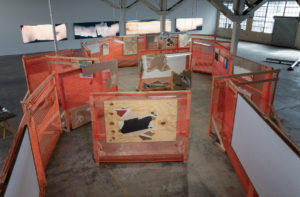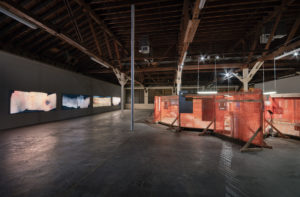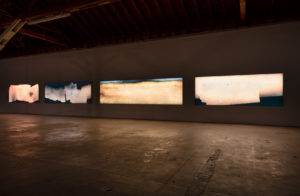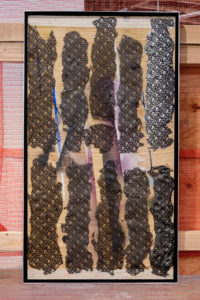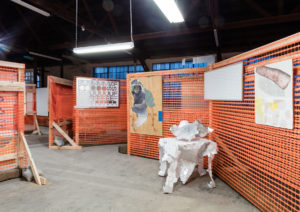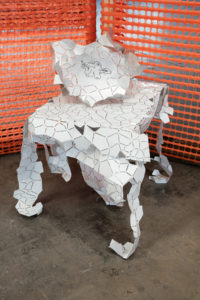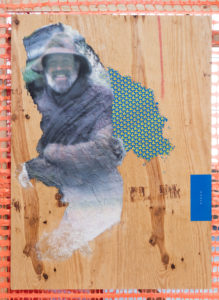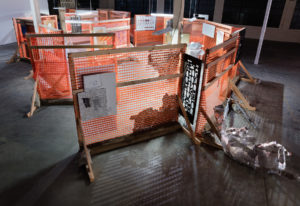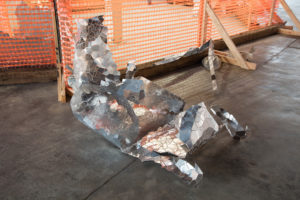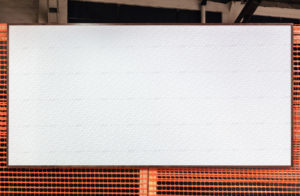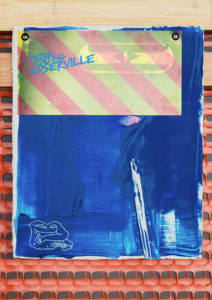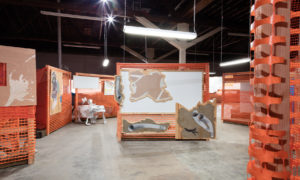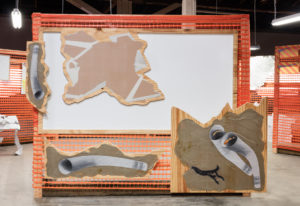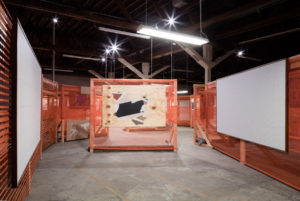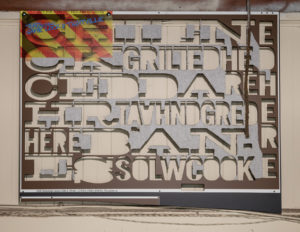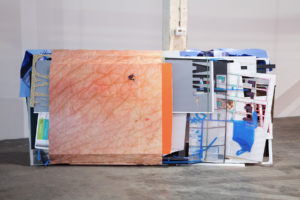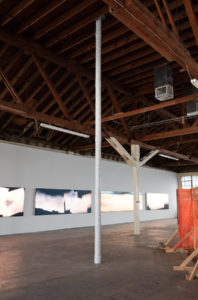Seth Price: Wrok Fmaily Freidns
- Seth Price in conversation with Laura Owens, January 2016
Conducted on the occasion of Seth Price’s solo exhibition at 356 Mission
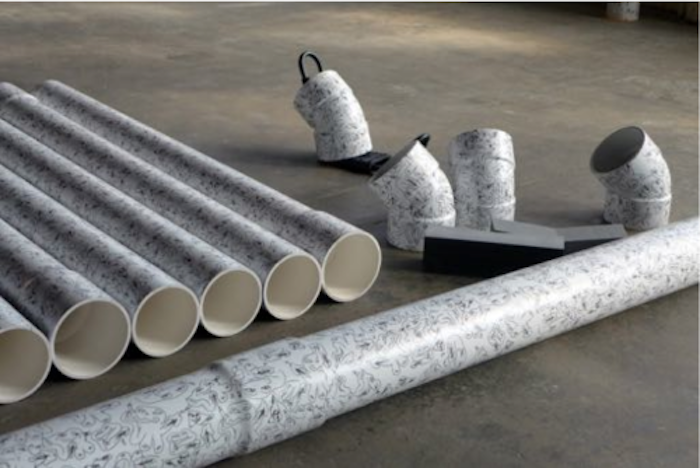
Laura Owens: So this is all new work for the show. We were looking at this PVC pipe you printed on. You called it a diversion and said that something you liked about the sewer pipe was that it was both sexy and repulsive.
Seth Price: Yeah, it’s this kind of hard industrial plastic they might use for medical purposes, for prosthetics and machines in hospitals. There is something about that that’s sexy and fucked up. And gross, I mean these pipes carry sewage.
LO: Right, and we were talking about these pencil shafts too.
SP: Yeah, they’re hollow too.
LO: What material are those?
SP: They’re printed, it’s an image of a pencil that is hollow, it becomes a hole that can suck or blow air. LO: But it’s not a straw, right? It’s a former pencil.
SP: Yeah. You couldn’t suck through it, it’s got the eraser on the other end.
LO: But it’s missing the lead?
SP: It’s like an abyss inside.
LO: So it’s like a potential to draw. The exterior refers to a pencil, but the interior is the void.

SP: Yeah, it’s creative, but in the stupidest way. The yellow pencil and pink eraser is so grade school. It can’t do anything. With the other pipes, I started thinking about this idea that a tube combines the shaft of the penis and the hole of an orifice—it could be an anus, or a vagina, or both at the same time—and this is a pencil but it can’t write so it’s not a pencil. I guess it can erase.
LO: And this idea shows up again in the drawings that get silk screened onto some of the PVC pipe. These figures are pencils, but have a penis that is also an orifice. It looks even more figurative because it has this anthropomorphic bend, almost like an elbow or a limb. It also is the type of pencil that is going to put down a few ideas. There is an impetus to jot some things down, but it’s actually just a black hole. No jotting is going to happen.
SP: Right, no jotting.
LO: The other thing that I was drawing a parallel to is the photography for the light boxes which you made with this start-up company‘s camera that almost goes for an archeological perspective on an object, taking thousands of photographs over a very small space. There is a way to go deep into something, but at the same time it’s a paradox because you’re photographing skin, which is a surface layer. It’s not like you’re going through. And then there’s a kind of parallel to these candid pictures that you took of New York City, these found archaeological sites.
SP: Oh, they’re of construction sites.
LO: Right, but it’s almost like a ruin. Do you see any connection between those images?
SP: I hadn’t thought about it. I don’t feel like I can make any connections between any of the work. I just wanted to throw like ten ideas into the air with this show. I just hope it’s fun to look at.
LO: What’s interesting is that the two places your mind would go would be microscopic, but then blown- up, details of skin or the body, but then also an urban, found, debris-field.
SP: It looks like ruins when they put up these new buildings.
LO: Like Smithson. They are ruins in reverse.
SP: Exactly. But all the tubes, pipes, classic formless blobs, ripped-up paper, nastiness, discarded material, it’s not just the Smithson ruins-in-reverse idea, it is also an apocalyptic negation of everything that they are hoping to put into these new condominiums.
LO: I don’t know why it makes so much formal sense to see these non-decision-decisions that are made about stacking these different materials. It is like when people talk about painting and they talk about those types of spaces where decisions aren’t so controlled but there is an accumulation of decisions that are heterogeneous. They don’t seem like they should go together, but they do go together.
SP: Do you think about that?
LO: I think about that when I’m looking at someone’s art.
SP: But not when you’re making?
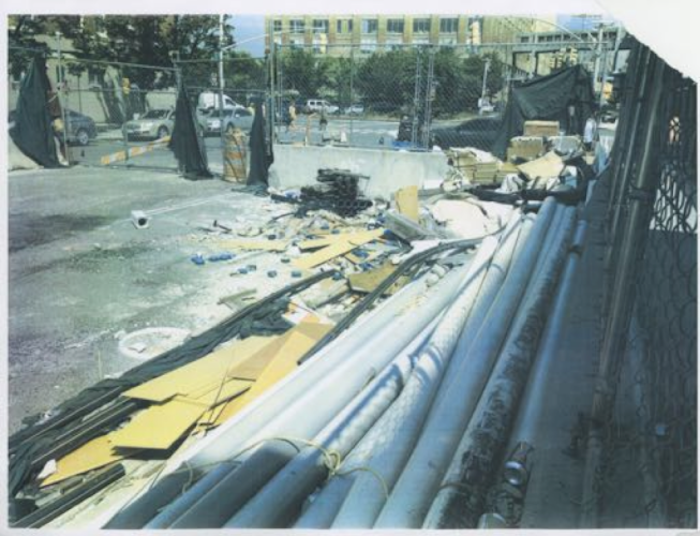
LO: After I make something, or when I’m at a pause, I think about the types of space or the types of marks and the differences between them. When I look at this construction site. it just seems so formally right. I don’t know if it’s because so many sculptors have looked at these types of piles and been informed by them in the 20th century.
SP:Also this printer is fucked up, so it looks so awesome. You just can’t get away from how amazing mistakes look.
LO: You talked about wanting to approach this show in a different way, where you have a volume of space. And maybe these pictures of construction site zones are a non-controlled, non-hierarchical space- making.
SP: It’s true. I haven’t gotten any closer to the idea of making some volumetric object to be contemplated in the round. I still can’t get myself to make that unique, stand-alone sculpture.
LO: Well I guess that’s why I was trying to describe this camera that you were trying to describe to me. When I look at those spaces, I think about how you don’t see it in the round, but you are viewing it…
SP: … Totally fragmented. The machine does this in the most practical and efficient manner possible, it breaks the subject area into an X and Y grid and then it proceeds through each point on the grid and shoots pictures downward toward the subject in a “Z-stack,” a stack of shots with a different focal length for each photo. Then it goes to the next spot on its grid and does the same thing. Then a software package turns each stack into a single focused shot, and then a panorama program algorithmically stitches all of those pieces into larger units, and then we assemble those… It’s pure data gathering. This project was about diving into massive data. When you look at one of the pictures printed out at small size, like in a book or something, it looks like nothing special. What makes it bizarre is the level of detail, and you can only see that when it’s printed super large.
LO: And I’m surprised by how unfamiliar something like skin becomes. It has a multiplicity of meaning and an extreme translucency that I have thought about with Ghirlandaio’s Virgin and Child. It looks like there’s a light bulb inside the virgin’s skull. That’s his genius, he illuminates how translucent the skin is.
SP: But there’s also something so boring about it, which I respond to on the level of someone who likes to make things. You get to a place where you’re making something and you feel like it’s horrible but you also have a kind of internal meter that can tell you where your discomfort with its being horrible is actually a good sign. I feel like you can spend your whole career trying to hone that instrument so you can know exactly when it’s so bad it’s great. These pictures make me think, “What the fuck am I doing? I’m taking some picture of some random person’s forearm that takes two weeks to process?
LO: There is also an absurdity to taking something that is always stretched around a form and making it flat.
SP: That was sort of the starting point. Shooting pictures around someone’s knee gives you a bunch of flat images, of course, and when you put them together you unwrap that knee, and unwrapping makes it very strange topographically, like that kneecap over there. When I showed a photo of that one at the drawing show, people asked what it was, whether it was a wound, or if it was pornographic. Honestly, I don’t know where any of this stuff comes from… But Three 5-6 Mafia seems like a cool place to play around. Has anyone called it Three 5-6 Mafia before?

LO: No, that’s really good. Did all of the skin models work out, or were some rejected?
SP: No, no rejection here, it’s like open arms here in the studio.
LO: And you were saying that for one of the photos you looked for someone with older skin?
SP: Oh yeah, we advertised for a surfer who was in his late forties, at least. We got hooked up with that guy, it was awesome, great guy, lots of character in that skin, sun damage and scars.
LO: Have you done photographic portraiture before?
SP: Not since high school.
LO: Did you click the button, or did you tell someone to click it?
SP: The robot does it, you have to line it all up in the program beforehand, like, demarcate the operational zone, and then the robot arm starts doing its thing and five hours later you have like ten thousand photos of an area as big as a keyboard.
LO: And what about breathing and other natural movement? Does that fuck it up?
SP: No, you use extremely high shutter speeds and take thousands and thousands of picture, and there’s tons of redundancy, there are shots to the right and left of each picture that overlap so the software can sort it out and ideally toss out blurs caused by movement. But on the other hand it’s really not made for moving subjects. Actually the software had a huge problem with this job.
LO: So, it’s another sort of absurdity that you picked this software that’s meant to photograph a static object.
SP: It is meant to photograph a dead insect. And the stitch software is meant for putting together panoramas of the Grand Tetons. That’s why we had to call in a retoucher at the end to iron it all out: you need a human eye to say what’s supposed to go where, because machine vision is kind of ruthless. But it creates all kinds of interesting fuck-ups along the way. That’s the other thing we love about machines, right, ruthless fuck-up-creation capability.
LO: It reminds me of another painting idea: you’re trying to get your hand out of it, but still have this idea that there is anomaly and expression. To have this spontaneity caused by other means.
SP: Everything balanced just right. Is that, like, a holy grail for painters?
LO: I think it is. That’s what I liked about your new book. You almost get to all these little holy grails. You’re kind of being critical, but at the same time…
SP: Are you thinking about all these things with the paintings you’re making right now? Because, if I’m correct, you’re working with inkjet-
LO: No, just screen printing.
SP: Where’s the inkjet. I don’t like that you’re hating on inkjet.
LO: No, I make stuff with inkjet. It’s all on paper, though. I haven’t gotten to the inkjet on canvas yet. I make a lot of books, they’re oversized.
SP: Yeah, I love those books. Do you generate an image of lemons, for example, or is that taken from somewhere?
LO: That particular image was taken from a found illustration, then it was composited to make what I want.
SP: Right, so basically you would, like, scan it and redraw it.
LO: I wanted a continuous pattern, so I made a repeating tile out of it.
SP: Well, that’s kind of what we do here. Once you have all the pieces, which are kind of found by the machine and put together in a Frankenstein’s-monster fucked-up way, you call in a human to clean it up. The retoucher sees himself as an artist, and is working from this tradition of fashion ads and editorial. Then we feed that through a 3D rendering program to add this glistening, plastic/gel thing. I guess that’s the fully synthetic part of this process, neither all machine nor all human. You have a human operator willfully using a software tool to make an amalgamation of CGI vision and human retouching.

LO: I’ve hired those people to fix installation shots, and they are used to a certain kind of advertising light, which you have to always ask them, “Please don’t do that.”
SP: It’s like when you get artwork photographed, where people are delivering you photos where you’re like, “What happened to the walls?” I don’t know… I’m just hoping to just leave everything in pieces, from now on, forever.
LO: That sounds good.
SP: I want to take it all apart and leave it in pieces, the more the better. I guess that was the principal thinking behind all this work.
LO: Well, something I really liked about the drawing show I saw is that it felt like unique frames became a way to organize the exhibition, but then anything could go in those frames. From the deep past, recent past… A lot of shows you see with a lot of drawings, you don’t really go into each drawing, but somehow the way the exhibition was with these fragments of ideas from different periods, that you start to make connections between, or not… You really slow down with it, which I thought was great and unusual.
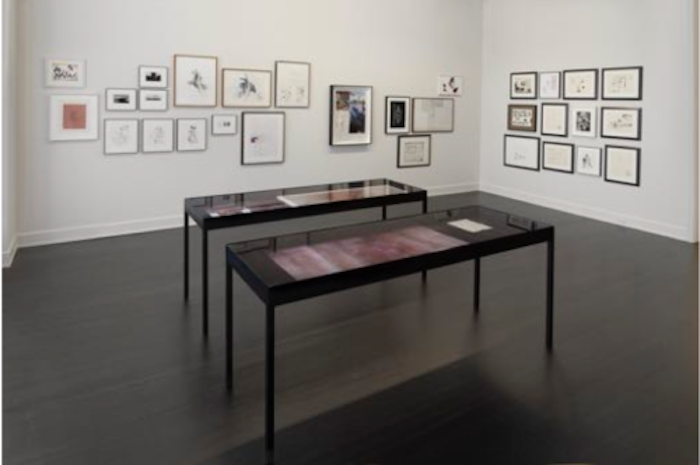
SP: Oh, great.
LO: But I think it’s also that there is a kind of looking at a drawing that you’re supposed to do, which would come up every once in a while, but all kinds of other ideas, like language, or note-taking, graphics, would start slipping in. It’s not just like, “here is a thoughtful rendering, or a pre-idea.”
SP: Did you ever do a show of sketches or drawings? Repertory stuff. LO: Yeah, I was just telling you I showed all those studies.
SP: But that was within a larger show?LO: Yeah.
SP: How did you do it, vitrines or something?
LO: No, it was all crammed together salon-style. I don’t know if it really worked.
SP: That was a while ago, now, right?
LO: No, I’ve done this weird thing where I’ve had a sketchbook and I’ve actually remade the sketchbook, as a piece. Kind of verbatim. I took xeroxes of every page, did wintergreen transfers, and then made a handmade book that’s a duplicate of that sketch book.
SP: Cool. I did something like that, did I ever show you that Poems book?
LO: No, I don’t think so.
SP: I just scanned pages from notebooks, and called them poems.
LO: So they may or may not have language on them?
SP: Drawings too, but mostly language. Little notes you make sometimes, like when you hear something fucked up on the subway and you go somewhere surprising, and you randomly add something later, and it’s a poem… Just a slight transposition to another realm. All of a sudden it becomes art if you make a wintergreen transfer, or call it a poem. You do just enough to be able to call it something else.
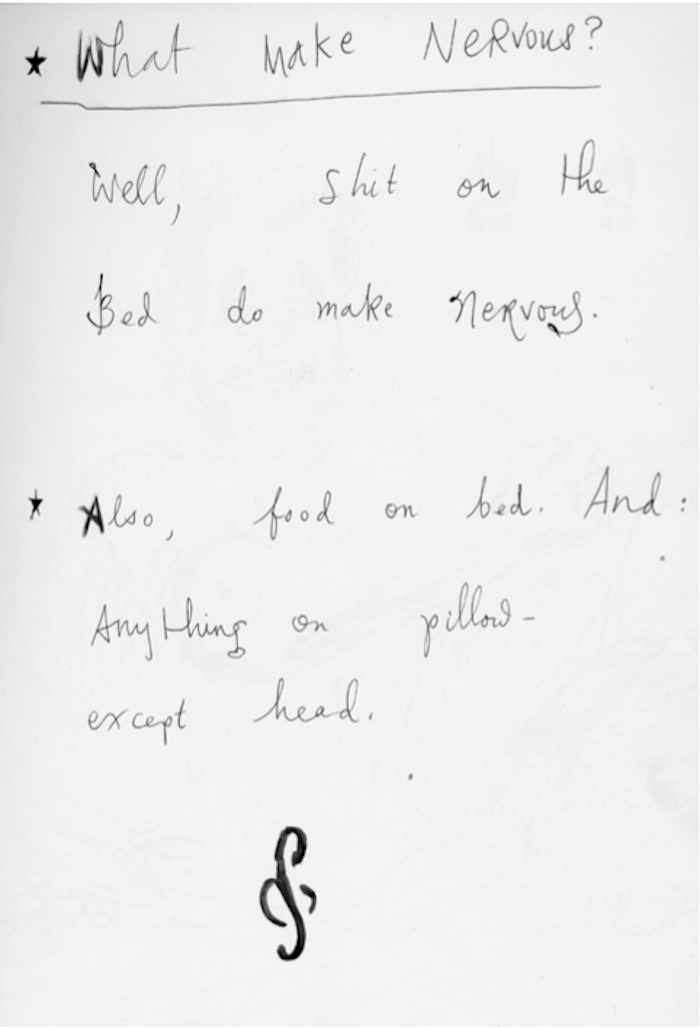
LO: Going back to these photographs, I think it’s really interesting that there are so many directions they could go in, and I think that’s what you’ve avoided. I think that’s what you meant—I don’t know if you said the word “banality,” but you were talking about an evenness of the photographs of the skin.
SP: When there is a kind of lack of interest. It took me a while to come to grips with that. I kept asking the retoucher, “Can we make it pop a little more? Are there some insane colors we can pull out of this motherfucker?” But then you realize that this is the way it is, it’s fundamentally an image that is fascinating and repulsive but also boring and banal. There’s almost nothing there but then of course there’s a lot there. It’s arbitrary, some random person’s skin, but skin is such a charged thing.
LO: But somehow you have uncharged it, as much as you can.
SP: Well, race is something to think about, it was worrisome to me to put up these huge glowing light boxes.
LO: I recently did this whole show with newspapers I found in the walls of my house. It’s the thing you print the newspaper from, but they’re all from April, 1942, so it’s all ‘Nazis and the Japs’, and it’s very loaded.
SP: “The thing you print the newspaper from,” meaning what?
LO: So, it’s the pre-plate. It’s a paper mold. A positive that they would make the negative plate from. And then that plate would print the newspaper.
SP: Was this in LA?
LO: It’s in my house in LA, so it’s the LA Times. I found these things that look like something you just ink up and print. So I did that. I would then print the negative. But then I made molds of them to get the positive, which was amazing, I was able to get pretty detailed photographs out of it. I then printed and scanned all of those. Then I enlarged those scans into screens to make paintings from them. It came to me because when I took the shingles off my house, it was being used as insulation, it was a discarded, recycled material of the ‘40s. When I printed them, all the information is highly charged, you know, Hitler and anti-Japanese rhetoric. I am relating it to your picking a subject like skin that you allow yourself to go toward, where there is a lot of implied meaning. It’s the closest I’ve gotten in a long time to using something that I know would be like, “Whoa, you came to Vienna and chose to talk about Hitler.” I think it’s interesting, this moment where you evade meaning, or allow meaning to be more elusive. Then maybe some meaning happens, but you don’t know what’s going to happen with it.
SP: It’s exciting to make material that might be charged. I was on the subway this morning, just looking at ads and graphics on people’s T-shirts. I had a moment of being so sick of language. I let my gaze drift up to the metal bars, and beige plastic in the ceiling, and heating grates in the subway, because I needed to get away from this mediated language that’s all around us in the culture, and I suddenly understood the appeal of those of us who are making, say, entirely abstract sculpture. Because I’ve worked mostly with images, ideas, and concepts that are in the culture, in language and media, I don’t really make abstract work. It can feel abstracted—ideally, even—but not abstract in the sense of Specific Objects or whatever. But I suddenly felt the appeal this morning on the subway. And there is something in some of these skin images that is so boring that it’s kind of like a breath of fresh air.
Laura Owens is an artist and the founder of 356 Mission

